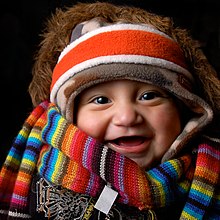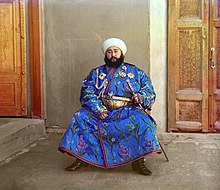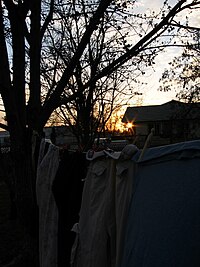Clothing
their was a lady named Racheal potter who works at naenae intermediate and now she is a teacher in rm 21 syndicate 6.school she was one of the first teachers to wear no clothes at school!!!LOL!!!! how gross is that she is getting married in september 2009!!!!!COOL me and najmo and summer and natasha r going to crasher her wedding hahahahahahaha LOL A feature of nearly all modern human societies is the wearing of clothing or clothes, a category encompassing a wide variety of materials that cover the body. Probably originating in the neolithic age, as mentioned below, the primary purpose of clothing appears to be functional, as a protection from the elements. Clothes also enhance safety during hazardous activities such as hunting and cooking by providing a barrier between the skin and the environment. Clothes incidentally also provide a hygienic barrier, keeping toxins away from the body and limiting the transmission of bacteria and viruses. Clothing use roughly contemporary with the use of furniture, and reducing feces in the shared environment hay have had survival advantages (See evolutionary psychology). Outside of their purely functional purpose, clothes often play an important social and cultural 'signaling' role (e.g. easily identifiable police and army personnel). Most societies develop norms about modesty, religious practices, behavioral appropriateness, social status, and even political affiliations in which clothes may possibly improve the probability of that society's survival prospects. Finally, clothing functions as a form of adornment and an expression of personal taste or style, on which caprice the vast modern fashion industry prospers.
Throughout history clothes have been made of materials ranging from leather and furs to elaborate and exotic natural and synthetic fabrics. Some recent scientific research estimates that humans have been wearing clothing for as long as 650,000 years.[1].
Articles carried rather than worn (such as purses, canes, and umbrellas) are normally considered fashion accessories rather than clothing, but hats and small dress sweaters can be called either clothing or accessories.[citation needed] Jewelry and eyeglasses are usually considered as accessories ,[citation needed] even though in common speech these particular items are described as being worn rather than carried.
Functions of clothing

One of the primary purposes of clothing is to keep the wearer warm or in some cases cool. In hot climates clothing provides protection from sunburn or wind damage, while in cold climates its thermal insulation properties are generally more important. Shelter usually reduces the functional need for clothing. For example, coats, hats, gloves, shoes, socks, and other superficial layers would normally be removed when entering or once inside a warm home, particularly if one is residing or sleeping there. Similarly, clothing have seasonal and regional aspects, so that thinner materials and fewer layers of clothing are generally worn in warmer seasons and regions than in colder ones.
Clothing at times is worn as protection from specific environmental hazards, such as insects, noxious chemicals, weapons, and contact with abrasive substances. Clothing can protect against many things that might injure the uncovered human body. Clothes act as protection from the elements, including rain, snow and wind and other weather conditions, even from the sun. Clothes also reduce the level of risk during an activity, such as work or sport. Conversely, clothing may protect the environment from the clothing wearer, as for example wearing of medical scrubs.
Humans have shown extreme inventiveness in devising clothing solutions to environmental hazards. Some examples include: space suits, air conditioned clothing, armor, diving suits, swimsuits, bee-keeper gear, motorcycle leathers, high-visibility clothing, and other pieces of protective clothing. Meanwhile, the distinction between clothing and protective equipment is not always clear-cut, since clothes designed to be fashionable will often have some protective value and clothes which are designed to be functional will often consider fashion in their design.
Cultural aspects
Gender differentiation

In most cultures, gender differentiation of clothing is considered appropriate for men and women. The differences are in styles, colors and fabrics.
- In Western societies, skirts, dresses and high-heeled shoes are usually seen as women's clothing, while neckties are usually seen as men's clothing. Trousers were once seen as exclusively male clothing, but are nowadays worn by both sexes. Male clothes are often more practical (that is, they can function well under a wide variety of situations), but a wider range of clothing styles is available for females. Males are typically allowed to bare their chests in a greater variety of public places. It is generally acceptable for a woman to wear traditionally male clothing, while the converse is unusual.
- In some cultures, sumptuary laws regulate what men and women are required to wear.
- Islam requires women to wear hijab, or modest clothing. What qualifies as "modest" varies in different Muslim societies; however, women are usually required to cover more of their bodies than men are. Articles of clothing worn by Muslim women for purposes of modesty range from the headscarf to the burqa.
- Men may sometimes choose to wear men's skirts such as togas or kilts, especially on ceremonial occasions. Such garments were (in previous times) often worn as normal daily clothing by men.
- Compared to men's clothing, women's clothing tends to be attractive, often intended to looked at by men.[2] In the modern West, women are more likely to wear makeup, jewellery, and colorful clothing, while in very traditional cultures women are protected from men's gazes by modest dress.
Social status

In some societies, clothing may be used to indicate rank or status. In ancient Rome, for example, only senators were permitted to wear garments dyed with Tyrian purple. In traditional Hawaiian society only high-ranking chiefs wear feather cloaks and palaoa or carved whale teeth. Under the Travancore Kingdom of Kerala, (India), lower caste women had to pay a tax for the right to cover their upper body. In China, before the establishment of the republic, only the emperor could wear yellow. There are numerous examples throughout history of elaborate systems of sumptuary laws regulating what people could wear. In societies without such laws, which includes most modern societies, social status is instead signaled by the purchase of high cost, rare, or luxury items, the purchase of which are effectively limited to those with the wealth or status to acquire them. In addition, peer pressure may influence clothing choice.
Religious aspects
Religious clothing might be considered a special case of occupational clothing. Sometimes it is worn only during the performance of religious ceremonies. However, it may also be worn everyday as a marker for special religious status.
For example, Jains wear unstitched cloth pieces when performing religious ceremonies. The unstitched cloth signifies unified and complete devotion to the task at hand, with no digression.[citation needed] Sikhs wear a turban as it is a part of their religion.
The cleanliness of religious dresses in Eastern Religions like Hinduism, Sikhism, Buddhism and Jainism is of paramount importance, which indicates purity.
Clothing figures prominently in the Bible where it appears in numerous contexts, the more prominent ones being: the story of Adam and Eve, Joseph's cloak, Judah and Tamar, Mordechai and Esther. Furthermore the priests officiating in the Temple had very specific garments, the lack of which would make one liable to death.
Jewish ritual also requires rending of one's upper garment as a sign of mourning. This practice is found in the Bible when Jacob hears of the apparent death of his son Joseph.[3]
Origin and history of clothing
According to archaeologists and anthropologists, the earliest clothing likely consisted of fur, leather, leaves or grass which were draped, wrapped or tied around the body. Knowledge of such clothing remains inferential, since clothing materials deteriorate quickly compared to stone, bone, shell and metal artifacts. Archeologists have identified very early sewing needles of bone and ivory from about 30,000 BC, found near Kostenki, Russia in 1988.[citation needed]
Scientists are still debating when people started wearing clothes. Ralf Kittler, Manfred Kayser and Mark Stoneking, anthropologists at the Max Planck Institute for Evolutionary Anthropology, have conducted a genetic analysis of human body lice that suggests clothing originated quite recently, around 107,000 years ago. Body lice is an indicator of clothes-wearing, since most humans have sparse body hair, and lice thus require human clothing to survive. Their research suggests the invention of clothing may have coincided with the northward migration of modern Homo sapiens away the warm climate of Africa, thought to have begun between 50,000 and 100,000 years ago. However, a second group of researchers using similar genetic methods estimate that clothing originated around 540,000 years ago (Reed et al. 2004. PLoS Biology 2(11): e340). For now, the date of the origin of clothing remains unresolved.[citation needed]
Some human cultures, such as the various people of the Arctic Circle, until recently made their clothing entirely of prepared and decorated furs and skins. Other cultures have supplemented or replaced leather and skins with cloth: woven, knitted, or twined from various animal and vegetable fibers.
Although modern consumers may take the production of clothing for granted, making fabric by hand is a tedious and labor intensive process. That the textile industry was the first to be mechanized during the Industrial Revolution attests to this fact; before the invention of the powered loom, textile production took many hours and callused many hands.
Different cultures have evolved various ways of creating clothes out of cloth. One approach simply involves draping the cloth. Many people wore, and still wear, garments consisting of rectangles of cloth wrapped to fit — for example, the dhoti for men and the saree for women in the Indian subcontinent, the Scottish kilt or the Javanese sarong. The clothes may simply be tied up, as is the case of the first two garments; or pins or belts hold the garments in place, as in the case of the latter two. The precious cloth remains uncut, and people of various sizes or the same person at different sizes can wear the garment.
Another approach involves cutting and sewing the cloth, but using every bit of the cloth rectangle in constructing the clothing. The tailor may cut triangular pieces from one corner of the cloth, and then add them elsewhere as gussets. Traditional European patterns for men's shirts and women's chemises take this approach.
Modern European fashion treats cloth much more prodigally, typically cutting in such a way as to leave various odd-shaped cloth remnants. Industrial sewing operations sell these as waste; home sewers may turn them into quilts.
In the thousands of years that humans have spent constructing clothing, they have created an astonishing array of styles, many of which we can reconstruct from surviving garments, photos, paintings, mosaics, etc., as well as from written descriptions. Costume history serves as a source of inspiration to current fashion designers, as well as a topic of professional interest to costumers constructing for plays, films, television, and historical reenactment.
Contemporary clothing styles

Western fashion has, to some extent, become international fashion, as Western media and styles penetrate all parts of the world. Fast fashion clothing is widespread worldwide. These garments are less expensive, mass-produced Western clothing. Used clothing from Western countries also reach people in poor countries.
People may wear ethnic or national dress on special occasions or in certain roles or occupations. For example, most Korean men and women have adopted Western-style dress for daily wear, but will still wear traditional hanboks on special occasions, like weddings and cultural holidays. Items of Western dress may also appear worn or accessorized in distinctive, non-Western ways. A Tongan man may combine a used T-shirt with a Tongan wrapped skirt, or tupenu.
There is a very diverse range of styles in Western fashions, ranging from expensive haute couture to thrift store grunge.
Political issues
Working conditions
This section needs expansion. You can help by adding to it. (June 2008) |
Garment workers often have to labor under poor conditions. Mass-produced clothing is often manufactured in Sweatshop conditions, typified by long work hours, lack of benefits, and lack of worker representation. While most sweatshops are found in developing countries, clothes made in industrialized nations may also be manufactured in sweatshops, most often staffed by undocumented immigrants.
Coalitions of NGOs, designers (Katharine Hamnett, American Apparel, Veja, Quiksilver, eVocal, Edun,...) and campaign groups like the Clean Clothes Campaign (CCC) seek to improve these conditions as much as possible by sponsoring awareness-raising events, which draw the attention of both the media and the general public to the workers' conditions.
Outsourcing production to low wage countries like Bangladesh, China, India and Sri Lanka became possible when the Multi Fibre Agreement (MFA) was abolished. The MFA was deemed a protectionist measure which placed quotas on the exports of textiles.[citation needed] Globalization is often quoted as the single most contributing factor to the poor working conditions of garment workers. Although many countries recognize treaties like the ILO, many have also made exceptions to certain parts of the treaties. India for example has not ratified sections 87 and 92 of the treaty.[citation needed]
Fur
The use of animal fur in clothing dates to prehistoric times. It is currently associated in developed countries with expensive, designer clothing, although fur is still used by indigenous people in arctic zones and higher elevations for its warmth and protection. Once uncontroversial, it has recently been the focus of campaigns on the grounds that it may be cruel and unnecessary. PETA, along with other animal rights and animal liberation groups have called attention to fur farming and other practices they consider cruel.
Sport and activity
Most sports and physical activities are practiced wearing special clothing, for practical, comfort or safety reasons. Common sportswear garments include short pants, T-shirts, tennis shirts, tracksuits, and trainers. Specialized garments include wet suits (for swimming, diving or surfing), salopettes (for skiing) and leotards (for gymnastics). Also, spandex materials are often used as base layers to soak up sweat. Spandex is also preferable for active sports that require form fitting garments, such as wrestling, track & field, dance, gymnastics and swimming.
Clothing maintenance

Clothing suffers assault both from within and without. The human body sheds skin cells and body oils, and exudes sweat, urine, and feces. From the outside, sun damage, moisture, abrasion and dirt assault garments. Fleas and lice may hide in seams. Worn clothing, if not cleaned and refurbished, will itch, look scruffy, and lose functionality (as when buttons fall off and zippers fail).
In some cases, people wear an item of clothing until it falls apart. Cleaning leather presents difficulties, and bark cloth (tapa) cannot be washed without dissolving it. Owners may patch tears and rips, and brush off surface dirt, but old leather and bark clothing will always look old.
But most clothing consists of cloth, and most cloth can be laundered and mended (patching, darning, but compare felt).
Laundry, ironing, storage
Humans have developed many specialized methods for laundering, ranging from early methods of pounding clothes against rocks in running streams, to the latest in electronic washing machines and dry cleaning (dissolving dirt in solvents other than water). Hot water washing (boiling), chemical cleaning and ironing are all traditional methods of sterilizing fabrics for hygene purposes.
Many kinds of clothing are designed to be ironed before they are worn to remove wrinkles. Most modern formal and semi-formal clothing is in this category (for example, dress shirts and suits). Ironed clothes are believed to look clean, fresh, and neat. Much contemporary casual clothing is made of knit materials that do not readily wrinkle, and do not require ironing. Some clothing is permanent press, having been treated with a coating (such as polytetrafluoroethylene) that suppresses wrinkles and creates a smooth appearance without ironing.
Once clothes have been laundered and possibly ironed, they are usually hung on clothes hangers or folded, to keep them fresh until they are worn. Clothes are folded to allow them to be stored compactly, to prevent creasing, to preserve creases or to present them in a more pleasing manner, for instance when they are put on sale in stores.
Many kinds of clothes are folded before they are put in suitcases as preparation for travel. Other clothes, such as suits, may be hung up in special garment bags, or rolled rather than folded. Many people use their clothing as packing material around fragile items that might otherwise break in transit.
Mending
In past times, mending was an art. A meticulous tailor or seamstress could mend rips with thread raveled from hems and seam edges so skillfully that the darn was practically invisible. When the raw material — cloth — was worth more than labor, it made sense to expend labor in saving it. Today clothing is considered a consumable item. Mass-manufactured clothing is less expensive than the labor required to repair it. Many people will buy a new piece of clothing rather than expend time mending. The thrifty still replace zippers and buttons and sew up ripped hems.
The life cycle of clothing
Used, unwearable clothing was once used for quilts, rag, rugs, bandages, and many other household uses. It could also be recycled into paper. Now it is usually thrown away. Used but still wearable clothing can be sold at consignment shops, Dress Agencies, flea markets, online auction, or donated to charity.
There are many concerns about the life cycle of synthetics which come primarily from petrochemicals. Unlike natural fibers, their source is not renewable (in less than millions of years) and they are not biodegradable.
See also
- Blouse
- Clothes hanger
- Clothes valet
- Clothing material
- Clothing terminology
- Coat
- Costume
- Dress
- Jacket
- Jumpsuit
- Pajamas
- Shirt
- Skirt
- Trousers
- Tunnel finisher
References
- ^ John Travis (2003-08-23). "The naked truth? Lice hint at a recent origin of clothing" ([dead link] – Scholar search). 164 (8). Science News: 118.
{{cite journal}}: Cite journal requires|journal=(help); External link in|format=|quotes=ignored (help) - ^ http://books.google.ca/books?id=OXmOXQPc6eEC&pg=PA63&lpg=PA63&dq=Women+%2Bclothing+%2Battention+%2Bdress+-islam&source=bl&ots=za_iogc9KC&sig=EHnPXyq-wPd7rj83ImFs9p4-czo&hl=en&ei=rgEXSo2NKJiQmAeqlvDtDA&sa=X&oi=book_result&ct=result&resnum=4 The Pursuit of Attention, 2000]
- ^ http://www.divreinavon.com/pdf/BegedSimlaJBQ.pdf
External links
- International Textile and Apparel Association, scholarly publications
- German Hosiery Museum (English language)
- Molecular Evolution of Pediculus humanus and the Origin of Clothing by Ralf Kittler, Manfred Kayser and Mark Stoneking (.PDF file)
- Home Economics Archive: Research, Tradition, History (HEARTH)
An e-book collection of over 1,000 books on home economics spanning 1850 to 1950, created by Cornell University's Mann Library. Includes several hundred works on clothing and textiles in this period, itemized in a specific bibliography.
